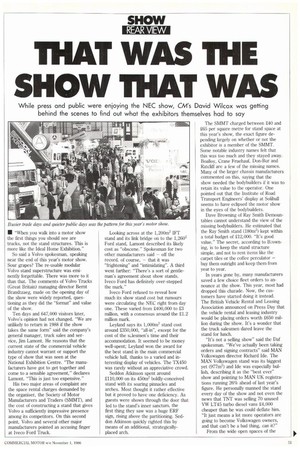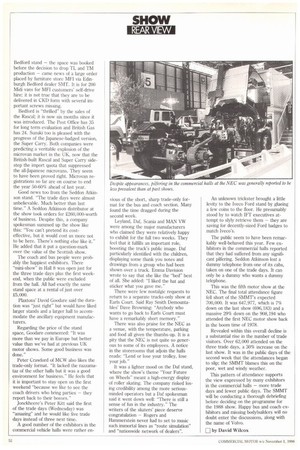THAT WAS THE SHOW THAT WAS
Page 53

Page 54

If you've noticed an error in this article please click here to report it so we can fix it.
"When you walk into a motor show the first things you should see are trucks, not the stand structures. This is more like the Ideal Home Exhibition."
So said a Volvo spokesman, speaking near the end of this year's motor show. Sour grapes? The re-usable modular Volvo stand superstructure was eminently forgettable. There was more to it than that. The comments of Volvo Trucks (Great Britain) managing director Bernt Brandtzaeg, made on the opening day of the show were widely reported, questioning as they did the "format" and value of the show.
Ten days and 647,000 visitors later, Volvo's opinion had not changed. "We are unlikely to return in 1988 if the show takes the same form" said the company's general manager, truck sales and service, Jim Lamont. He reasons that the current state of the commercial vehicle industry cannot warrant or support the type of show that was seen at the National Exhibition Centre. "The manufacturers have got to get together and come to a sensible agreement," declares Lamont. "This is just too expensive."
His two major areas of complaint are the space rental charges demanded by the organiser, the Society of Motor Manufacturers and Traders (SMMT), and the cost of constructing a stand that gives Volvo a sufficiently impressive presence among its competitors. On this second point, Volvo and several other major manufacturers pointed an accusing finger at Iveco Ford Truck.
Looking across at the 1,200m2 stand and its link bridge on to the 1,2602 Ford stand, Lamont described its likely cost as "obscene." Spokesman for two other manufacturers said — off the record, of course, — that it was "frightening" and "intimidating". A third went further: "There's a sort of gentleman's agreement about show stands. Iveco Ford has definitely over-stepped the mark."
Iveco Ford refused to reveal how much its show stand cost but rumours were circulating the NEC right from day one. These varied from £400,000 to £3 million, with a consensus around the £1.2 million mark.
Leyland says its 1,000m2 stand cost around £350,000, "all-in", except for the cost of the si.lesmen's time and their accommodation. It seemed to be money well-spent; Leyland won the award for the best stand in the main commercial vehicle hall, thanks to a varied and interesting display of vehicles. The TX450 was rarely without an appreciative crowd.
Seddon Atkinson spent around £110,000 on its 450m2 boldly-conceived stand with its soaring pinnacles and arches. Most thought it rather effective but it proved to have one deficiency. As guests were shown through the door that led to the stand's inner sanctum, the first thing they saw was a huge ERF sign, rising above the partitioning. Seddon Atkinson quickly righted this by means of an additional, strategicallyplaced arch.
The SMMT charged between £40 and £65 per square metre for stand space at this year's show, the exact figure depending largely on whether or not the exhibitor is a member of the SMMT. Some notable industry names felt that this was too much and they stayed away. Boalloy, Crane Fruehauf, Don-Bur and Ratcliff are a few of the missing names. Many of the larger chassis manufacturers commented on this, saying that the show needed the bodybuilders if it was to retain its value to the operator. One pointed out that the Institute of Road Transport Engineers' display at Solihull seems to have eclipsed the motor show in the eyes of the bodybuilders.
Dave Browning of Ray Smith Demountables cannot understand the view of the missing bodybuilders. He estimated that the Ray Smith stand (180m2) kept within a total budget of £12,000. "It's good value." The secret, according to Browning, is to keep the stand structure simple, and not to rent items like the carpet tiles or the coffee percolator — buy them outright and keep them from year to year.
In years gone by, many manufacturers saved a few choice fleet orders to announce at the show. This year, most had dropped this charade. Now, the customers have started doing it instead. The British Vehicle Rental and Leasing Association announced on Press Day that the vehicle rental and leasing industry would be placing orders worth £650 million during the show. It's a wonder that the truck salesmen dared leave the stand for lunch.
"It's not a selling show" said the Daf spokesman. "We've actually been taking orders and signing contracts" said MAN Volkswagen director Richard Ide. The MAN Volkswagen stand was its biggest yet (977m2) and Ide was especially bullish, describing it as the "best ever" show and pointing to MAN UK registrations running 26% ahead of last year's figure. He personally manned the stand every day of the show and not even the news that TNT was selling 70 unused VW LT45 turbo diesel vans £4,000 cheaper than he was could deflate him. "It just means a lot more operators are going to become Volkswagen owners, and that can't be a bad thing, can it?"
From the wide open spaces of the Bedford stand — the space was booked before the decision to drop IL and TM production — came news of a large order placed by furniture store MFI via Edinburgh Bedford dealer SMT. It is for 200 Midi vans for MFI customers' self-drive hire; it is not true that they are to be delivered in CKD form with several important screws missing.
Bedford is "thrilled" by the sales of the Rascal; it is now six months since it was introduced. The Post Office has 35 for long term evaluation and British Gas has 24. Suzuki too is pleased with the progress of the Japanese-badged version, the Super Carry. Both companies were predicting a veritable explosion of the microvan market in the UK, now that the British-built Rascal and Super Carry sidestep the import quota that suppressed the all-Japanese microvans. They seem to have been proved right. Microvan registrations so far are on course to end the year 50-60% ahead of last year.
Good news too from the Seddon Atkinson stand. "The trade days were almost unbelievable. Much better than last time." A Seddon Atkinson distributor at the show took orders for 2260,000-worth of business. Despite this, a company spokesman summed up the show like this: "You can't pretend its costeffective, but it would cost us more not to be here. There's nothing else like it." He added that it put a question-mark over the value of the Scottish show.
The coach and bus people were probably the happiest exhibitors. There "mini-show" in Hall 8 was open just for the three trade days plus the first weekend, when the public were excluded from the hall. All had exactly the same stand space at a rental of just over £5,000.
Plaxtons' David Goodare said the duration was "just right" but would have liked larger stands and a larger hall to accommodate the ancillary equipment manufacturers.
Regarding the price of the stand space, Goodare commented: "It was more than we pay in Europe but better value than we've had at previous UK motor shows. Some good business was done."
Peter Crawford of MCW also likes the trade-only format. "It lacked the razzamataz of the other halls but it was a good environment for business." He feels that it is important to stay open on the first weekend "because we like to see the coach drivers who bring parties — they report back to their bosses."
Jonckheere's Peter Kitt said the first of the trade days (Wednesday) was "amazing" and he would like five trade days instead of three next time.
A good number of the exhibitors in the commercial vehicle halls were rather en vious of the short, sharp trade-only format for the bus and coach section. Many found the time dragged during the second week.
Leyland, Daf, Scania and MAN VW were among the major manufacturers who claimed they were relatively happy to exhibit for the full two weeks. They feel that it fulfills an important role, boosting the truck's public image. Daf particularly identified with the children, displaying some thank you notes and drawings from a group who had been shown over a truck. Emma Davision wrote to say that she like the "bed" best of all. She added: "I liked the hat and sticker what you gave me."
There were few nostalgic requests to return to a separate trucks-only show at Earls Court. Said Ray Smith Demountables' Dave Browning: "Anybody who wants to go back to Earls Court must have a remarkably short memory."
There was also praise for the NEC as a venue, with the temperature, parking and food all given the thumbs-up. It is a pity that the NEC is not quite so generous to some of its employees. A notice in the storerooms that adjoin the halls reads: "Lend or lose your trolley, lose your job."
It was a lighter mood on the Daf stand, where the show's theme "Your Future on Wheels" meant a high-energy display of roller skating. The company risked losing credibility among the more seriousminded operators but a Daf spokesman said it went down well: "There is still a sense of fun in the industry." The writers of the skaters' piece deserve congratulation — Rogers and Hammerstein never had to set to music such immortal lines as "route simulation" and "nationwide network of dealers". An unknown trickster brought a little levity to the Iveco Ford stand by glueing a few coins to the floor. He presumably stood by to watch IFT executives attempt to slyly retrieve them — they are saving for decently-sized Ford badges to match Iveco's.
The public seem to have been remarkably well-behaved this year. Few exhibitors in the commercial halls reported that they had suffered from any significant pilfering. Seddon Atkinson lost a dummy telephone from one of its cabs, taken on one of the trade days. It can only be a dummy who wants a dummy telephone.
This was the fifth motor show at the NEC. The final total attendance figure fell short of the SMMT's expected 700,000. It was 647,977, which is 7% down on the last show (696,183) and a massive 29% down on the 908,194 who attended the first NEC motor show back in the boom time of 1978.
Revealed within this overall decline is a substantial rise in the number of trade visitors. Over 62,000 attended on the three trade days, a 30% increase on the last show, It was in the public days of the second week that the attendances began to slip; the SMMT blames this on the poor, wet and windy weather.
This pattern of attendance supports the view expressed by many exhibitors in the commercial halls — more trade days and fewer public days. The SMMT will be conducting a thorough debriefing before deciding on the programme for the 1988 show. Happy bus and coach exhibitors and missing bodybuilders will no doubt enter the discussions, along with the name of Volvo.




















































































